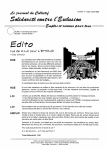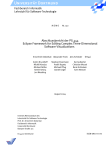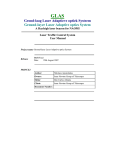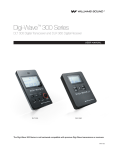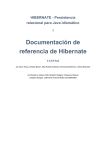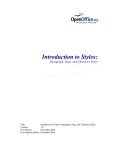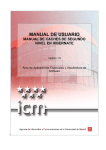Download ETC-42 Plugin Manual - Projects at LAM
Transcript
ETC-42 : Universal Exposure Time Calculator
Plugin Framework Manual
Laboratoire d'Astrophysique de Marseille
Centre donneeS Astrophysique de Marseille
Authors:
N. Apostolakos,
P.Y. Chabaud,
C. Surace
January 2012
Contents
1 Introduction
2
2 Required skills
2
3 Framework Design
3
4 Development Prerequisites
3
5 PluginFrame
4
2.1 Java programming language . . . . . . . . . . . . . . . . . . . . . . . . .
2.2 Swing framework . . . . . . . . . . . . . . . . . . . . . . . . . . . . . . .
5.1
5.2
5.3
5.4
Initialization . . . . .
Menu Determination .
Logic Implementation
Non GUI plugins . . .
.
.
.
.
.
.
.
.
6 PluginCommunicator
6.1
6.2
6.3
6.4
6.5
6.6
6.7
6.8
getCurrentSession() . . . .
sessionModied() . . . . .
getAvailableDatasetList()
getDataset() . . . . . . . .
createDataset() . . . . . .
createMultiDataset() . . .
runSimulation() . . . . . .
showResults() . . . . . . .
.
.
.
.
.
.
.
.
.
.
.
.
.
.
.
.
.
.
.
.
.
.
.
.
.
.
.
.
.
.
.
.
.
.
.
.
.
.
.
.
.
.
.
.
.
.
.
.
.
.
.
.
.
.
.
.
.
.
.
.
.
.
.
.
.
.
.
.
.
.
.
.
.
.
.
.
.
.
.
.
.
.
.
.
.
.
.
.
.
.
.
.
.
.
.
.
.
.
.
.
.
.
.
.
.
.
.
.
.
.
.
.
.
.
.
.
.
.
.
.
.
.
.
.
.
.
.
.
.
.
.
.
.
.
.
.
.
.
.
.
.
.
.
.
.
.
.
.
.
.
.
.
.
.
.
.
.
.
.
.
.
.
.
.
.
.
.
.
.
.
.
.
.
.
.
.
.
.
.
.
.
.
.
.
.
.
.
.
.
.
.
.
.
.
.
.
.
.
.
.
.
.
.
.
.
.
.
.
.
.
.
.
.
.
.
.
.
.
.
.
.
.
.
.
.
.
.
.
.
.
.
.
.
.
.
.
.
.
.
.
.
.
.
.
.
.
.
.
.
.
.
.
.
.
.
.
.
.
.
.
.
.
.
.
.
.
.
.
.
.
.
.
.
.
.
.
.
.
.
.
.
.
.
.
.
.
.
.
.
.
.
.
.
.
.
.
.
.
.
.
.
.
.
.
2
2
4
4
5
5
6
. 6
. 6
. 7
. 8
. 8
. 9
. 9
. 10
7 Data Model
10
8 Calculation Results
10
8.1 Result Levels . . . . . . .
8.2 Result Types . . . . . . .
8.2.1 String results . . .
8.2.2 Single value results
8.2.3 Dataset results . .
8.2.4 Image results . . .
8.2.5 Image Set result .
8.3 Retrieving the results . . .
8.4 Adding new results . . . .
.
.
.
.
.
.
.
.
.
.
.
.
.
.
.
.
.
.
.
.
.
.
.
.
.
.
.
.
.
.
.
.
.
.
.
.
.
.
.
.
.
.
.
.
.
.
.
.
.
.
.
.
.
.
9 Plugin Deployment
.
.
.
.
.
.
.
.
.
.
.
.
.
.
.
.
.
.
.
.
.
.
.
.
.
.
.
.
.
.
.
.
.
.
.
.
.
.
.
.
.
.
.
.
.
.
.
.
.
.
.
.
.
.
.
.
.
.
.
.
.
.
.
.
.
.
.
.
.
.
.
.
.
.
.
.
.
.
.
.
.
.
.
.
.
.
.
.
.
.
.
.
.
.
.
.
.
.
.
.
.
.
.
.
.
.
.
.
.
.
.
.
.
.
.
.
.
.
.
.
.
.
.
.
.
.
.
.
.
.
.
.
.
.
.
.
.
.
.
.
.
.
.
.
.
.
.
.
.
.
.
.
.
.
.
.
.
.
.
.
.
.
.
.
.
.
.
.
.
.
.
.
.
.
.
.
.
.
.
.
10
11
11
11
11
11
11
12
12
12
1
1
Introduction
The ETC-42 exposure time calculator has been designed to be as generic and exible as possible,
so it can be used for as many instruments as possible. As a generic tool though, it can only
accept generic input parameters and it produces as output only some common ETC results. To
support instruments which require some specic treatment of the input and to allow the ETC-42
users to produce extra outputs (or even outputs depending on multiple simulation executions),
the plugin framework is provided. This document describes this framework in detail and it
serves as a reference for the plugin developers.
2
Required skills
The plugin framework is designed to make the extension of the ETC-42 as easy as possible as
far as it concerns the plugin developers, without requiring any modication of the ETC-42 core.
There are though some basic skills a developer should have, to be able to implement successfully
ETC-42 plugins.
2.1 Java programming language
ETC-42 itself is written in Java, so the plugins also must be written in the same language. This
means that the knowledge of the Java language is a requirement for being able to write a ETC-42
plugin. A good place for learning the Java language is the online tutorial provided by Oracle,
which can be found on the following page:
http://download.oracle.com/javase/tutorial/
If a developer wants to implement the logic of the plugin in a dierent language, this is
still possible, as long as the part of the plugin which communicates with the ETC-42 core is
implemented in Java. For the communication between this part of the plugin and the code
implemented with the dierent language there are two options:
• To build a native library and use the JNI (Java Native Interface) for directly calling its
methods from Java
http://java.sun.com/developer/onlineTraining/Programming/JDCBook/jni.html
• To build an executable program and call it from Java using the Runtime.getRuntime().exec()
method, using les for the input/output exchange
It is though strongly recommended to build the plugins entirely in Java.
2.2 Swing framework
In most of the cases the ETC-42 plugins will provide some kind of GUI for communicating with
the user. The ETC-42 GUI is build using the Swing framework and all plugins are required to
do the same. In fact, all the plugins are forced to extend the JFrame class. A good tutorial for
Swing can be found on this link:
2
http://download.oracle.com/javase/tutorial/ui/index.html
To ease the plugin development, it is highly recommended to use a Swing GUI builder for all
the non trivial plugin GUIs. All the popular IDEs provide such builders.
For development of plugins without any GUI window please see the section 5.4.
3
Framework Design
The ETC-42 plugin framework has been designed to separate as much as possible the implementation of the plugins from the core of the ETC-42. The gure 1 shows this design.
Figure 1: Plugin Framework Design
As it is visible on the gure, the plugin framework has three main parts. The PluginFrame
(described in section 5) is the class which all the plugins must extend. The PluginCommunicator
(described in section 6) is the way of the plugin to communicate with the core of the ETC-42 and
to retrieve or set some conguration, to execute the simulation or to show some results. Finally,
the DataModel (described in section 7) is the representation of the ETC-42 conguration.
4
Development Prerequisites
To develop ETC-42 plugins the only prerequisite is the jar le of the ETC-42. This le can be
downloaded from the following link:
http://projets.oamp.fr/projects/etc/wiki/Downloads
This jar contains all the required classes. The plugin developers should set it as a dependency
to their ETC-42 plugin projects. Note that during execution, ETC-42 already has access to
these classes, so when the developers pack the plugins in a jar le, they should not include the
contents of this jar (or the jar itself), to create smaller jar les.
3
5
PluginFrame
The PluginFrame class is the class which all the plugins must extend. Itself extends the JFrame
class, so all the plugins have at least one GUI window (see section 5.4 for how to implement non
GUI plugins). This will be the window the ETC-42 will show when the plugin will be lunched.
5.1 Initialization
The implementations of the PluginFrame class must have a public default constructor (a
constructor without arguments). This will be the constructor the ETC-42 will use to create the
plugin instance. The use of any other constructors by the plugin framework is not possible, but
their existence is not forbidden (as they might be useful for testing purposes or for standalone
execution of the plugin).
Note that during the execution of the constructor the plugin does not have access to the
communicator yet. During this time only initialization which is not depended from communication with the ETC-42 core is possible. The initialization depended on the core of the ETC-42
should happen in the method initialize (PluginCommunicator communicator), which must be
implemented by all the plugins. This method will be called after the execution of the constructor and before the main plugin frame is shown.
5.2 Menu Determination
Each PluginFrame must be annotated with the @Plugin annotation. This annotation has two
parameters, the menuPath and the tooltip . The menuPath is a mandatory parameter and it
denes the menu path from where the plugin will be executed. This parameter accepts a list of
strings representing names of sub-menus. The last string on the list is the name of the plugin.
Note that the ETC-42 has a menu called Plugins and the path dened with the annotation is
always under this menu. It is not possible to place plugins under a dierent menu. The tooltip
parameter is optional and it denes a string which will be presented to the user when he will
hover the mouse above the menu item of the plugin.
For example, to implement a plugin which will be available under the menu "Plugins ->
My Plugins -> Run the plugin...", the following class should be created:
2
@Plugin ( menuPath={"My P l u g i n s " , "Run t h e p l u g i n . . . " } , t o o l t i p="My f i r s t p l u g i n " )
public class MyPlugin extends PluginFrame {
public MyPlugin ( ) {
4
6
//
of
the
frame
goes
here
}
@Override
protected void
8
10
Initialization
// ETC−42
i n i t i a l i z e ( PluginCommunicator communicator ) {
core
related
initialization
}
...
4
goes
here
This class will have as result the menu on the gure 2:
Figure 2: Plugin Menu Example
The plugin developers should always chose reasonable plugin names to avoid name conicts
as much as possible. The ETC-42 will handle name conicts by using an increasing counter
as a postx, but this makes the plugin selection unclear (because the correct plugin has to be
determined by reading its tooltip). Of course same names for sub-menus can be used to group
plugins together.
5.3 Logic Implementation
Except of the restrictions mentioned above, the ETC-42 plugin developers are free to implement
the plugin logic as they like. For the communication between the plugin frame and the core of
the ETC-42 they can use the PluginCommunicator class (described on section 6), which can be
retrieved with the method getCommunicator() of the PluginFrame class.
The most common way implementing a plugin is to include in the GUI a button, which, when
pressed, executes the logic of the plugin, and several input elds (like text elds, etc) to receive
the users input.
5.4 Non GUI plugins
As mentioned on the sections above, all the ETC-42 plugins are forced to have at least one GUI
window. There is though the need of having plugins which do not need user input, so the step
of showing a window and pressing a button is redundant (and even maybe annoying). In this
section is described how to implement this kind of plugins. Note though that interactive user
input will not be available for such plugins (command line plugins are not supported).
The non GUI plugins still need to extend the PluginFrame class, like all the ETC-42 plugins,
so they will actually have a GUI window, but this will never be visible. The ETC-42 plugin
framework shows the plugin windows by using the setVisible (boolean b) method. A plugin
which does not need to have a visible window should override this method to do nothing. For
example:
@Override
2
public void
//
4
Do
s e t V i s i b l e ( boolean b ) {
nothing
here
so
the
window
will
}
5
not
be
visible
Plugins which override this method will not be able to receive interactive user input, so all
the logic of the plugin needs to be implemented in the initialize (communicator) method.
6
PluginCommunicator
The PluginCommunicator class is the way of communication between the plugins and the core
of the ETC-42. The plugins can retrieve an instance of this class to use, by using the method
getCommunicator() of the PluginFrame class. Here are described all the methods the communicator provides and how to use them to implement the plugin logic.
6.1 getCurrentSession()
The method getCurrentSession should be used to retrieve the current conguration of the ETC42. The current is the one that the user has currently selected on the ETC-42 GUI and is the
one which will be used if a simulation will be lunched.
The method returns an instance of the Session class. This object can be used to retrieve the
necessary information for populating any GUI elements of the plugin or for performing the plugin
calculations. For a detailed description of how to use the Session class and the Data Model in
general please see section 7.
Note that the returned object is mutable (its state can be modied). The modications are
possible via the dierent setter methods of the Instrument, Site , Source and ObsParam objects.
Any modications done by the plugin will be reected to the core ETC-42. This is the way
of the plugin to modify the ETC-42 conguration.
As a simple example, imagine a plugin operating for spectrographs and it uses as source
an emission line. The plugin might want to set the wavelength range for which the simulation
will run according the wavelength and the FWHM of the emission line, to limit the amount of
calculations. This can be done with the following code:
//
Retrieve
the
session
from
the
communicator
2 S e s s i o n s e s s i o n = getCommunicator ( ) . g e t C u r r e n t S e s s i o n ( ) ;
//
Read
the
emission
lines
wavelength
and FWHM
4 Source source = s e s s i o n . getSource ( ) ;
double wavelength = s o u r c e . g e t E m i s s i o n L i n e W a v e l e n g t h ( ) ;
6 double fwhm = s o u r c e . getEmissionLineFwhm ( ) ;
// S e t t h e w a v e l e n g t h r a n g e o f t h e c a l c u l a t i o n t o 2 ∗FWHM
8 Instrument instrument = s e s s i o n . getInstrument ( ) ;
i n s t r u m e n t . setRangeMin ( wavelength − fwhm ) ;
10 i n s t r u m e n t . setRangeMax ( wavelength + fwhm ) ;
6.2 sessionModied()
Even though when a plugin changes a parameter in the session the data model in the ETC-42
core is also updated, the GUI windows are not notied automatically for the new values. This
6
design was chosen mainly for performance reasons, both for the main ETC-42 window and the
plugins themselves.
The way to update the values shown on the main ETC-42 window is to call the method
sessionModied() of the PluginController. The plugins should call this method before disposing
their windows if they make modications on the Session (otherwise the ETC-42 main GUI will
show old, invalid values), but they can also use it at any moment during their execution. This,
with combination that the plugin frames are not modal (they are not locking the ETC-42 main
frame), allows the development of plugins which can be used in parallel with the main ETC-42
window.
6.3 getAvailableDatasetList()
As it will described in the Data Model section (7), there are two dierent kinds of parameters in
the session, single values (like doubles, integers, etc) and datasets (representing a set of data).
Setting the single values is straight forward, as the related setter methods accept as parameters
Java primitive types.
Setting the datasets though is not as easy. The setters for the dataset parameters accept as
parameter a DatasetInfo object, which must describe an already existing dataset (see section 6.5
for how to create new datasets). If a plugin wants to let the user change a dataset parameter, it
must present to him the possible values to select from. The PluginCommunicator provides the
method getAvailableDatasetList() for exactly this reason.
This method gets two arguments, the dataset type and the namespace for which the available datasets will be returned. The namespace must be the name of the component (instrument,
site, etc) for which the dataset list will be retrieved and the type is an enumeration dening
the specic parameter of the component (for details see section 7). The returned value of the
method is a list of DatsetInfo, representing all the available datasets for this parameter and for
the specied component.
For example, if a plugin wants to retrieve all the available datasets for the total transmission
of the instrument, the following code can be used:
//
Retrieve
the
instrument
from
the
communicator
2 I n s t r u m e n t i n s t r u m e n t = getCommunicator ( ) . g e t C u r r e n t S e s s i o n ( ) . g e t I n s t r u m e n t ( ) ;
//
Get
the
name
of
the
instrument
4 S t r i n g namespace = i n s t r u m e n t . g e t I n f o ( ) . getName ( ) ;
//
Retrieve
the
list
of
available
datasets
6 L i s t <D a t a s e t I n f o > a v a i l a b l e T r a n s m i s s i o n s =
getCommunicator ( ) . g e t A v a i l a b l e D a t a s e t L i s t ( Type . TRANSMISSION, namespace ) ;
7
6.4 getDataset()
For performance reasons the data model retrieved with the getCurrentSession() method does
not contain any data of the dataset parameters. The getter methods of these parameters return
objects of type DatsetInfo, which contain only the necessary information for retrieving the data
when necessary.
The retrieval of the data can be done by using the getDataset() method. The plugins can
use this method when they need the data for performing some calculation. This method accepts
three parameters, the dataset type, the DatsetInfo describing it and the option in the case of
a multi-dataset (it should be null for single datasets). The method returns an object of type
Datset. The data can be retrieved from this object with the method getData(), which returns an
ordered map containing all the data. The Datset object contain also other useful information,
like the units in which the data are expressed.
As an example, to retrieve the data of the total transmission of the current instrument, the
following code can be used:
//
Retrieve
the
instrument
from
the
communicator
2 I n s t r u m e n t i n s t r u m e n t = getCommunicator ( ) . g e t C u r r e n t S e s s i o n ( ) . g e t I n s t r u m e n t ( ) ;
//
Get
the
dataset
info
for
the
transmission
4 DatasetInfo i n f o = instrument . getTransmission () ;
//
Retrieve
the
data
6 D a t a s e t transm = getCommunicator ( ) . g e t D a t a s e t ( Type . TRANSMISSION, i n f o ,
Map<Double , Double> data = transm . getData ( ) ;
null ) ;
6.5 createDataset()
When a plugin wants to create a new dataset, the createDataset() method can be used. This
method gets the following parameters:
•
type: The type of the dataset to be created
•
info: A DatasetInfo object containing the name and the description of the dataset to be
created, as well as the namespace for which it will be available. If the namespace is null,
then the dataset will be globally available.
•
xUnit: The unit of the X axis
•
yUnit: The unit of the Y axis
•
data: A map containing the data of the dataset
Note that if there is already a dataset in the database with the same name-namespace pair,
the method will fail throwing NameExistsException. After the method creates the new dataset,
it also sets it as selected for the current session, so the plugins don't need to do this extra step.
Extra care needs to be given when setting the axis units. If the units of the dataset are wrong,
the ETC-42 will not perform the SNR calculation.
8
For example, the following code will create a new dataset for the instrument transmission,
which will dene a constant transmission of 0.8 for the wavelengths between 5000 and 10000
angstrom, and will be available only for the current instrument:
//
Get
the
name
of
the
instrument
to
use
as
namespace
2 I n s t r u m e n t i n s t r u m e n t = getCommunicator ( ) . g e t C u r r e n t S e s s i o n ( ) . g e t I n s t r u m e n t ( ) ;
S t r i n g namespace = i n s t r u m e n t . g e t I n f o ( ) . getName ( ) ;
4 // C r e a t e t h e d a t a s e t i n f o and t h e u n i t s
D a t a s e t I n f o i n f o = new D a t a s e t I n f o ( " 0 . 8 t r a n s m i s s i o n " , namespace ,
6
"A c o n s t a n t t r a n s m i s s i o n " ) ;
S t r i n g xUnit = "\u00C5" ; // An g st ro m
8 S t r i n g yUnit = null ; // T r a n s m i s s i o n i s u n i t l e s s
//
Generate
the
data .
Note
that
TreeMap
is
used
for
having
an
ordered
map
10 Map<Double , Double> data = new TreeMap<Double , Double >() ;
data . put ( 5 0 0 0 . , 0 . 8 ) ;
12 data . put ( 7 5 0 0 . , 0 . 8 ) ;
data . put ( 1 0 0 0 0 . , 0 . 8 ) ;
14 // C r e a t e t h e d a t a s e t
getCommunicator ( ) . c r e a t e D a t a s e t ( Type . TRANSMISSION, i n f o , xUnit , yUnit , data ) ;
6.6 createMultiDataset()
The createMultiDataset() method is very similar with the createDataset(), but it is used for
creating multi-datasets. A mutli-dataset contains multiple sets of data, called its options. Each
option has a key, which is a string, and it is used from the ETC-42 core to select the correct data
during the simulation.
The only dierence of the createMultiDataset() method from the createDataset() is that the
given data are is a map of type Map<String,Map<Double,Double>, which means it is a map of
pairs option-data.
6.7 runSimulation()
The ETC-42 plugins are not limited only on modifying the current session. They can also execute the ETC simulation as many times as they please, receiving the calculation results for
each execution. This way a script can produce outputs which require multiple executions of the
simulation (for example a plot of SNR values for dierent exposure times).
The method to execute the simulation is the runSimulation(). This method is synchronous,
which means that it will not return until the simulation is nished. The returned object is of
type CalculationResults and it contains all the available results of the simulation (nal, intermediate and debug). Please see the section 8 for more details about the results.
Note that when a plugin executes a simulation the ETC-42 core window will not show any
results automatically. This is done so plugins can run multiple simulations before producing
their output.
9
6.8 showResults()
The last method of the PluginCommunicator allows the plugins to use the ETC-42 results panel
for showing results to the user. This method accepts an object of type CalculationResults. The
plugins can pass as argument either the object returned from the runSimmulation() method, or
even create a new CalculationResults which will contain only their results. See the section 8 for
more information about the CalculationResults class and how to use it.
7
Data Model
The data model of the ETC-42 consists of three main components. These are the instrument,
which contains information about the telescope and the attached instrumentation, the site,
which contains information about the location where the telescope is located, the source, which
contains information about the astronomical target and the observing parameters, which contain the conguration of the specic observation (like exposure time, etc). The Session object
returned by the getCurrentSession() method is a container for an instance of each of the components.
A detailed description of all the parameters of the four components exists in the document [1].
For this reason this information will not be duplicated here. Please refer to this document for
more details.
8
Calculation Results
The plugins have access not only on the nal results of the ETC-42 simulation, but also to all
the intermediate calculated values. Because of that the number of the available results is big,
so a dedicated framework has been designed for representing the results of calculations. The
plugin developers need to know this framework both for using the results of a simulation and for
presenting extra results to the user via the ETC-42 results panel.
8.1 Result Levels
All the results of the ETC-42 simulations are divided in four levels. The dierent parts of the
ETC-42 can use the level information for ltering out results. The dierent levels are represented
with the CalculationResults.Level enumeration and the possible values are:
•
FINAL
The results which are considered as the nal output of the simulation
•
INTERMEDIATE IMPORTANqT
Results of intermediate calculations for which the users might be interested
•
INTERMEDIATE UNIMPORTANT
Results of intermediate calculations for which the users most probably will not be interested
10
•
DEBUG
The conguration for which the simulation run, available mainly for debugging reasons
A full list of the available results for each category can be found in the document [1]. The
algorithms used for producing every result can be found in the document [2].
8.2 Result Types
The ETC-42 results framework provides four main types of results. All the result types inherit
from the abstract class CalculationResults.Result, which just denes that all results should have
a specic name (for the available result names please refer the document [1]). The dierent result
types are the following.
8.2.1 String results
These are results which consist only from a string. The class which represents this type of results
is the CalculationResults.StringResult.
8.2.2 Single value results
These are results which consist from a single value and the unit in which it is expressed.
There are two types of single valued results, the CalculationResults.LongValueResult and the
CalculationResults.DoubleValueResult. One of them accepts as values only long integer values
and the other one accepts oating point of double precision values.
8.2.3 Dataset results
These are results which consist from a set of data. It contains the units of the two axis and
a map containing the pairs of data. The available dataset results are the CalculationResults.
LongDatasetResult, in which both axis are expressed as long integer values, the CalculationResults
.DoubleDatasetResult, in which both axis are expressed as oating point of double precision
values and the CalculationResults.LongDoubleDatasetResult, in which the X axis (the keys of
the map) is expressed as long integer and the Y axis (the values of the map) is expressed as
oating poing of double precision.
8.2.4 Image results
These are results which consist of a single, two dimensional image. The class representing this
type of results is the CalculationResults.ImageResult. This class contains an object of type Image,
which provides methods for retrieving the size of the image and the value of specic pixels.
8.2.5 Image Set result
These are results which keep a map with number keys and values Image instances. If, for example,
a calculated image varies with over the wavelength, the resulted data cube is shown with this
type of result.
11
8.3 Retrieving the results
After executing a simulation and obtaining an instance of CalculationResults, there are two ways
to access the results in it. The rst is the method getResultByName(name), which gets as argument the name of the result to retrieve. Note that for this method it does not matter the level of
the result. For a detailed description of the available result names please refer the document [1].
The second way is to use the method getResults( level ), which returns a map with all the results
of a specic level. The keys of the map are the result names.
Note that both methods return the type CalculationResults.Result. It is the responsibility of
the plugin developer to cast the result to the correct type.
8.4 Adding new results
If a plugin wants to use the ETC-42 main window to show some results, it needs to add them in
a CalculationResults object (it can use the instance retrieved after executing the simulation or
create a new one).
To add string, image or single value results there is only one way. The constructors of the
related classes must be used to create the result instances and then the addResult(result, level )
method can be used. This method can also be used for dataset and image set results.
For datasets and image sets though there is a second method, which can be used if the
total number of data (or images) is not known and the data (or images) are entered one at the
time. This can be done with the methods addResult(name, xValue, yValue, xUnit, yUnit, level)
and addResult(name, key, image, keyUnit, level). These methods will create the result with the
given name if it doesn't exist, or they will add the given data or image in it if it exists.
9
Plugin Deployment
The deployment of the ETC-42 plugins is fairly easy. The plugin developer needs just to create a
jar le containing the implementation of his plugin. Note that a single jar le can contain more
than one plugins and the plugins can be in any package. The ETC-42 will discover automatically
all the available plugins and there is no need for any conguration les.
It must be reminded here that the plugin jar le does not need to contain any of the classes
from the ETC-42 framework. These are already available during the execution of the ETC-42.
Including all these les will have as result unnecessarily big plugin jar les. For this reason
double check how the building method you use (IDE, ant, maven, etc) behaves.
There are two ways to deploy a plugin jar le to the ETC-42. The rst one is to copy it
manually in the plugins directory under the ETC-42 home directory. If not specied with the
−Detc.home parameter during execution (please see the ETC-42 user manual for more details),
the home directory is named .ETC and it is under the users home directory. After copying the
12
plugin jars in the plugins directory, the plugins can be reloaded either by restarting ETC-42 or
by selecting the Plugins -> Reload plugins menu (gure 3). This will result with the new
plugins being available under the Plugins menu.
Figure 3: Reload plugins menu
The second way to deploy a plugin is to use the Plugins -> Import plugins from JAR
menu (gure 4). This menu will open a window for selecting the JAR le containing the plugins
and it will handle its deployment without any further actions of the user.
Figure 4: Import plugins from JAR menu
In the case a plugin makes use of some external libraries (it has dependencies in one or more
other jar les), the library jar les must also be copied in the plugins directory. After copying
the les it is necessary to reload the plugins, either by restarting ETC-42 or by selecting the
Plugins -> Reload plugins menu (this needs to be done also when the second way of deployment is used). ETC-42 plugin framework will load all the jar les in the plugins directory and
will make available the classes in them to all the plugins.
An extra note must be given here for the way Eclipse exports a project as a jar le. Eclipse
(to solve the problem of including all the dependencies in one jar without unpacking them) is
creating an executable jar le which uses a customized class loader having the ability to load
classes from jars included inside the main jar. That means you cannot use the produced jar as
a library for other projects without including the jar les of all its dependencies separately, even
if everything works when this jar is executed. It is highly recommended to don't use this way
for packaging your plugin classes, as it might lead to confusion and also creates unnecessarily
big jar les. If though you really want to use this way, do not forget to also copy in the plugins
directory all the plugin dependencies.
13
References
[1] ETC-42 : Dictionary
http: // projets. oamp. fr/ projects/ etc/ wiki/ Documentation
[2] ETC-42 : Calculation Procedure
http: // projets. oamp. fr/ projects/ etc/ wiki/ Documentation
14
















